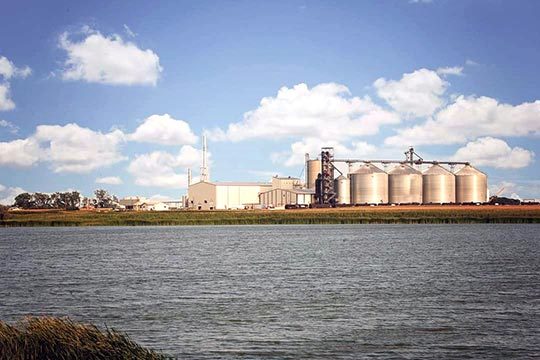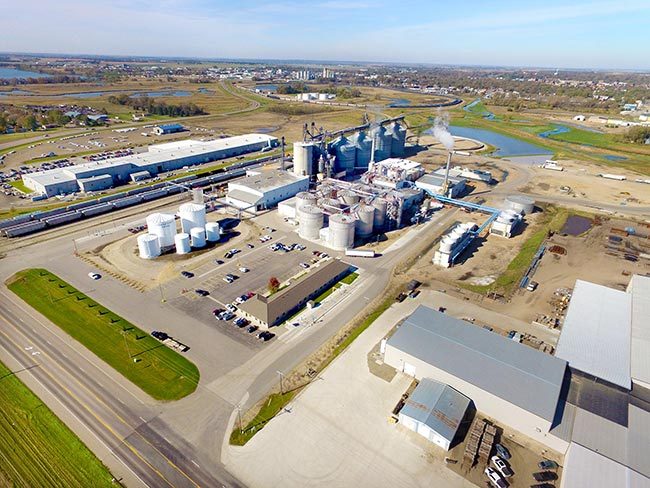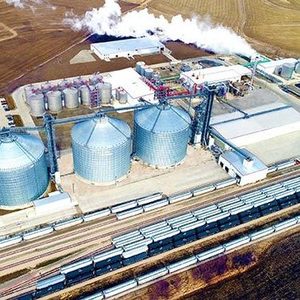Busy with Upgrades




PHOTO: GLACIAL LAKES ENERGY
April 7, 2023
BY Luke Geiver
Activity across the North American ethanol sector is never lacking. With more than 190 ethanol plants operating at some capacity in the U.S. alone, there’s always more going on at the facility level than casual observers realize. From capacity augmentations and tech upgrades to large-scale maintenance and replacement work, leading producers are continually executing on capacity and efficiency enhancements. Much of the work is low-profile, technical and of little interest to those outside the plant gates. But for those linked to the industry—producers, vendors, shareholders and growers—there’s a notable story behind every project. Here are four project updates that offer snapshots of trending plant improvements.
Enhancing the Farmer Experience at Elite Octane
Based in Atlantic, Iowa, Elite Octane LLC is a dry mill ethanol facility that began operations in 2018. Able to produce 150 MMgy, the plant features nine fermentation tanks (each rated for over 800,000 gallons of capacity) and three finished ethanol storage tanks rated to hold 2 million gallons each, giving the plant ample liquid capacity. On the DDGS side of the operation, the plant has a flat storage building able to hold 8,000 tons of dry coproduct. The facility also has a DDGS bulk-weigher and loadout system rated for 350 tons per hour and able to load a semi-truck in less than five minutes.
The plant has a long list of impressive features, but for Nick Bowdish, president and CEO of Elite, it is the facility’s enhanced ability to quickly handle incoming feedstock—and a lot of it—that’s most meaningful to area growers. Last year, the company added 4 million bushels of corn storage and a 30,000 bushels-per-hour receiving system. The expansion came online just prior to harvest and took the facility to a total of 8 million bushels of storage and 90,000 bushels-per-hour of receiving capacity.
“Elite Octane prides itself on offering great customer service and this investment acknowledges that a farmer’s time is one of the most valuable resources in agriculture today,” Bowdish says, adding that the project represents Elite’s renewed commitment to “continue to grow alongside farmers” in southwest Iowa.
Part of Elite’s story is its effort to continue to build off the previous site owner’s vision. Previous entrepreneurs interested in the benefit of an ethanol plant—specifically one in Cass County, Iowa, where the plant resides—built infrastructure over a two-year timeframe from 2006 to 2008. That work included constructing fermenter foundations, process tank foundations, energy center foundations, DDGS storage buildings, administration buildings and grading and drainage work, along with the installation of eight water wells.
The recent expansion effort was mainly linked to storage and site usability for farmers, Bowdish says. Buresh Building Systems completed the installation at Elite, which featured commercial grain bins manufactured by Sukup Manufacturing. The expansion also included a second inbound scale, a new probe shack with multiple probes, and an enhanced RFID card reading system provided by Compuweigh to upgrade the automation of the facility.
Storage and CI Reduction Focus at Dakota Ethanol
Dakota Ethanol near Wentworth, South Dakota, has also been expanding and upgrading its site. In 2022 the facility executed on several projects. Last August, Dakota Ethanol put in an eighth fermentor, which increased capacity above 100 MMgy (previous nameplate capacity was 90 MMgy), while also increasing production efficiency. To match current plant production capabilities, an additional grain bin install was also on the list. Nearly 1 million bushels of storage was added “to improve customer service and meet storage needed to match current plant production.”
On the outbound ethanol side, the plant added a new storage tank. At 2 million gallons, the tank will reportedly boost Dakota Ethanol’s ethanol storage capacity to 5 million gallons and, according to management, “help the plant buffer against logistical issues and railroad performance.”
Starting production over two decades ago, the plant was championed and developed by the members of Lake Area Corn Processors (comprised of growers, investors and community members), a group that transformed an idea into one of the area’s flagship workplaces. Today, their vision continues to evolve.
In addition to physical upgrades at the plant, Dakota Ethanol is an active promoter of low-carbon farming practices and, with the right policy supports, the carbon intensity (CI) score reduction associated with it. A visit to the plant’s online homepage shows that it is participating in the USDA’s Regional Conservation Partnership Program, part of a strategy to secure compensation for farmers who produce low-carbon intensity commodities through existing and future low-carbon fuel standard markets.
In 2021, the plant celebrated the production of 1 billion barrels of ethanol. The facility utilizes roughly 30 million bushels of corn and also produces corn oil, along with several distillers grains products sold as dry distillers grains with solubles, modified distillers with solubles, wet distillers with solubles and Dakota Cake, a proprietary product with higher moisture content than MDGS but lower moisture content than wet cake.
One Earth Energy Looks to Expand
Some of the construction work in the ethanol industry hasn’t even been officially announced (as of press time in late March). In Illinois, One Earth Energy LLC is in the early stages of making a major addition to its 150 MMgy ethanol facility. Steve Kelley, president and CEO, met with the Gibson City Council’s Planning and Zoning Commission in February to get a 103-acre tract adjacent to the existing plant rezoned from agriculture to manufacturing. The land is already owned by One Earth. In a vote of 5-0, the commission decided in favor of One Earth’s request and rezoned the land to be more suitable to the company’s expansion vision. The current footprint of the facility is 85 acres. Details of the future plans for the rezoned land have not yet been disclosed by One Earth Energy or Kelly. Even the Gibson City council members noted in their documentation of the recent meeting the lack of specifics for the rezoned property. The details should emerge later this year.
One Earth Energy, which is majority owned by Rex American Resources Inc., has also been exploring the possibility of carbon capture and sequestration. The ethanol producer has been working with the Illinois State Geological Survey over the past couple of years to determine if the 500,000 tons of CO2 the plant produces each year could be collected, liquefied and injected near the site. Early testing shows the geologic formation below the area would be favorable to a CO2 injection well.
Efficiency Upgrades at Glacial Lakes Energy
Glacial Lakes Energy, which owns and operates multiple ethanol facilities in northeastern South Dakota, has not only been active in promoting the use of E30, but also doing boots-on-the-ground work across its facilities in the areas of Aberdeen, Huron, Mina and Watertown.
In its recent quarterly newsletter, the plant’s executive team noted several changes across its locations. Going back to late 2019, additional fermentation capacity was anticipated for the Aberdeen (55 MMgy) and Huron (40 MMgy) plants to match the efficiencies being realized at the Mina (140-plus MMgy) and Watertown (130 MMgy) plants.
Although the Huron fermentation capacity work has been completed, the Aberdeen plant’s fermentation expansion work was still unfinished near the end Q4 2022, but may be finalized now. Delays in the receipt of electrical equipment needed for the expansion at Aberdeen were cited.
“Fermentation expansion at the two facilities is projected to boost the ethanol yield and corn oil production yield significantly,” GLE’s leadership team noted. Ethanol storage was also added at GLE, specifically in Huron. Management pointed out that the Huron location had outgrown its ethanol holding capacity, with only two days of production storage available.
“The addition of two larger finished ethanol storage tanks will increase that capacity to ten to twelve days,” they said.
This spring, all four plants will receive hammermill upgrades to improve efficiency and lower cost per unit. The team at GLE also said that other projects focused on the recovery of additional corn oil are being evaluated. At the Mina plant, a 1.2 million-bushel grain bin and two additional super pits are under construction and set to be complete by harvest 2023.
All of the work, according to GLE leadership, is driven by familiar guideposts. “The GLE management team is squarely focused on cost control, efficiency (higher yields) and lowering our CI scores.”
It’s fair to say that statement sums up not only GLE’s priorities, but the U.S. ethanol industry as a whole.
Author: Luke Geiver
Contact: editor@bbiinternational.com
PRINTED IN 2023 MAY EPM
Advertisement
Advertisement
Related Stories
The USDA’s Risk Management Agency is implementing multiple changes to the Camelina pilot insurance program for the 2026 and succeeding crop years. The changes will expand coverage options and provide greater flexibility for producers.
EcoCeres Inc. has signed a multi-year agreement to supply British Airways with sustainable aviation fuel (SAF). The fuel will be produced from 100% waste-based biomass feedstock, such as used cooking oil (UCO).
SAF Magazine and the Commercial Aviation Alternative Fuels Initiative announced the preliminary agenda for the North American SAF Conference and Expo, being held Sept. 22-24 at the Minneapolis Convention Center in Minneapolis, Minnesota.
Saipem has been awarded an EPC contract by Enilive for the expansion of the company’s biorefinery in Porto Marghera, near Venice. The project will boost total nameplate capacity and enable the production of SAF.
Global digital shipbuilder Incat Crowther announced on June 11 the company has been commissioned by Los Angeles operator Catalina Express to design a new low-emission, renewable diesel-powered passenger ferry.
Upcoming Events










